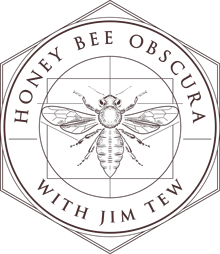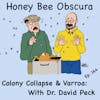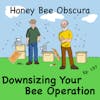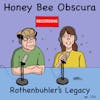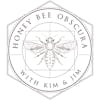Plain Talk: Honey Bee Eggs (173)

In this episode, Jim Tew takes listeners on an intricate journey into the life of a honey bee egg, uncovering its quiet but highly active existence. Despite the challenge of discussing such a microcosmic topic, Jim eloquently demystifies the...
In this episode, Jim Tew takes listeners on an intricate journey into the life of a honey bee egg, uncovering its quiet but highly active existence. Despite the challenge of discussing such a microcosmic topic, Jim eloquently demystifies the complexities surrounding the initial stage of a bee's life cycle. From the difficulties beekeepers face in spotting these tiny, almost ethereal eggs, to the importance of eggs as indicators of a queen's presence and health, this episode provides a deep dive into why understanding the egg stage is crucial for successful beekeeping.
Jim shares his techniques for egg-spotting, emphasizes the significance of observing egg patterns for assessing queen performance, and explores the fascinating embryological journey an egg undergoes from fertilization to hatching. The discussion also touches upon the potential impacts of environmental factors on eggs, such as exposure to sunlight during inspections and the innovative use of modern tools to aid in egg detection.
Listeners will gain insight into the queen's relentless egg-laying routine, which, while lacking glamour, underscores her crucial role in the hive's survival and productivity. With Jim's guidance, beekeepers are encouraged to view the honey bee egg not just as a simple beginning but as a marvel of biological engineering, essential for the continuation of the hive.
Join us on this episode of Honey Bee Obscura for an enlightening exploration of the honey bee egg, a topic as foundational as it is fascinating, revealing the unseen efforts that sustain the life of the hive.
Listen today!
______________________
This episode is brought to you by the support of Bee Culture Magazine: The magazine of American Beekeeping since 1873! Each month, Bee Culture delivers the best information in an easy to read magazine, full of content from beekeepers, researchers and regular contributors, including Jim Tew and Beekeeping Today Podcast's, Becky Masterman!
Subscribe today at: https://beeculture.com
______________________
Thanks to Betterbee for sponsoring today's episode. Betterbee’s mission is to support every beekeeper with excellent customer service, continued education and quality equipment. From their colorful and informative catalog to their support of beekeeper educational activities, including this podcast series, Betterbee truly is Beekeepers Serving Beekeepers. See for yourself at www.betterbee.com
______________________
Honey Bee Obscura is brought to you by Growing Planet Media, LLC, the home of Beekeeping Today Podcast.
Music: Heart & Soul by Gyom, All We Know by Midway Music; Christmas Avenue by Immersive Music; original guitar music by Jeffrey Ott
Cartoons by: John Martin (Beezwax Comics)
Copyright © 2024 by Growing Planet Media, LLC

Episode 173 – Plain Talk: Honey Bee Eggs
Jim Tew: Hello, podcast listeners, it's Jim Tew here with what I thought initially was a good idea for a subject for discussion. I was intrigued by it, but then I began to work on it, and I've kind of found myself in the deep end of the pool. We're going to see how this goes, but it's going to be somewhat difficult to keep this plain talk. Plain talk about what? About the quiet life of the honeybee egg.
Introduction: Welcome to Honeybee Obscura, brought to you by Growing Planet Media, the producers of the Beekeeping Today podcast. Join Jim Tew, your guide through the complexities, the beauty, the fun and the challenges of managing honeybees. Jim hosts fun and interesting guests who take a deep dive into the intricate world of honeybees. Whether you're a seasoned beekeeper or just getting started, get ready for some plain talk that'll delve into all things honeybees.
Jim: Listeners, without a doubt, one of the first things that beekeepers learn to do, try to learn to do, want to learn to do, have questions about, is how to see those eggs. Right off the bat, it's an experience. They are remarkably small. In fact, if you had something there before you, typewritten, hardly the size of a typewritten dash, and it doesn't weigh much more than that typewritten dash, is that honeybee egg. It's not easy to see those things. You know how the cell base has those three clefts in it formed by the walls on the opposing cells on the other side?
Those notches, when that propolis and wax is really polished up, can glisten back at you just like a honeybee egg. If you want to make it even worse, you could probably use white foundation. I suspect that's why most foundation is now black, in order to help you see those eggs. I still have similar problems with the polishing, showing me reflections that, in my aging eyes, can look like eggs.
It's really a useful tool to be able to see those eggs that are there. We all kept bees just more than a year. You know exactly why. It's an indication that your queen was there at least three days ago. Rather than just really tearing the colony apart to find that queen and have a look at her, what do when you actually see her? You do want to see her occasionally, just to know that she's healthy and velvet and physically fit.
Overall, you don't have to see her every time if you can just see her egg output. The way I normally do it, not because I'm looking for eggs the correct way, just because it's what I was taught, and I suspect all of you who've seen honeybee eggs routinely taught the same way, get the sunlight coming over your shoulder, hold the end bars of the frame pretty much in the center, get your bifocals adjusted and look right in the bottom of those cells around the larvae, probably in the middle of the frame, somewhere where you're expecting to see eggs.
That's going to be one of the center frames, by the way. It's probably not going to be the outside frames unless the cluster is not centered. Anything's possible, but in general, the eggs are going to be toward the center of the colony and the center frames. Now, as I'm saying that, I'm thinking about some people there pulling that center frame out, taking a chance on rolling your queen off, so I would pull out one of the edge frames and then work out toward one of those center frames by adding space so I don't roll those bees up when I pull those tight center frames out.
I got to know, I don't know where that queen is, and I don't want to hurt her while I look for evidence of her being on the job. Got that center frame out, have a look anywhere on the frame, probably out toward the edges some, hold it by the end bars, one end bar in each hand, rotate back and forth, let that sunlight catch and see if you can see those eggs glistening back at you in the bottom.
Now, I'm a man talking who's been keeping bees a long time. A lot of gadgets and gizmos have come along. There's all kind of magnifying lens for your eyes with lights on them. There's the kind of things that physicians and dentists wear that are reasonably affordable if you get the cheaper models. Listeners, I don't even know if I could use my cell phone to snap a picture of a frame and then have a look at it to see if I can enlarge that to see those eggs there.
There's a lot of possibility for lighting with this new cool LED lighting on pencils and a lot of things that might help us see those eggs that were not available to help us see those eggs 10, 15, 50 years ago. See the eggs though. What does that tell you? That tells you that the queen was there, in general, at least three days ago because it takes about three days for that egg to hatch. This is probably as good a time as any to tell you that that egg actually hatches in a range of days, anywhere, one paper said from two and three quarter days all the way over to four days.
It doesn't really matter to us immensely, but we just need to know that every one of these bee development stages has some time lag about it. All of those numbers about how long an egg is an egg, how long a larvae is a larvae and those kind of days. Those are all estimates, but in general, it takes about 21 days. There's that word, about, takes about 21 days for a worker bee to go from egg to adult.
Three days for the egg stage to hatch. Could be as long as six days on that. You can do strange things. You can put a frame, apparently. I've done it a few times for peculiar reasons, usually related to queen production. You can put a frame of eggs in the refrigerator, just a common refrigerator, and you can hold them there, apparently without long-term damage, according to some old work done in California. It's pretty common to see recommendations that if you need to hold a frame of eggs overnight, just put them in the refrigerator. There was some work, too.
I don't want to get too carried away here, but there was some work too that you can wrap that in a towel and actually hold larvae and suspend them, slow them down and then the next day still have those larvae suitable for the science you were working on or whatever you were trying to do. I'm jumping around here because when I'm back to the technique that I first started on, where I tell you to find the sunlight coming over your shoulder, I had a scientist years ago specifically say, Steve Tabor, Mr. Tabor is no longer here. He was at the Tucson lab, but he was adamant that if you stand there in that bright Tucson sun, and you're looking for those eggs and that larvae, that you are immediately using UV light to burn those larvae, sunburn them to the extent that in some cases they don't make it.
Anytime I'm looking for eggs, even here in my Ohio sunlight, but when I was doing it in my Alabama sunlight, I was aware of the fact that you probably shouldn't leave that frame and that sunlight any longer than you have to. Now, I've only talked to Mr. Tabor years ago. He also was the one who gave the instruction about putting eggs and larvae in the refrigerator for just a few days, a few hours at least.
He was the one who had the suggestions about the refrigerator and about the sunlight. Do something with that if you want. It does make sense, doesn't it? If you're in bright, hot sunlight, and you're looking for eggs, and you leave that frame standing out with the sun striking it, could be some damage done there. Just a cautionary note. You can get an idea of the spats of the queen. Just exactly how good of a job is she doing? I think we'll take a break here, and I'll pick right up on that point when we get back.
[music]
Bee Culture: Ready to take your beekeeping skills to the next level? Dive into Bee Culture, the magazine of American beekeeping, where each month you'll get expert insights, equipment tips, Varroa control strategies and sprinkles of humor from Stephen Bishop and Ed Colby. Exclusively for Honeybee Obscura listeners, subscribe now at beeculture.com for just $35 a year. Use the code podcast for a special bundle offer. Receive your hard copy delivered monthly along with full online digital access. Bee Culture, your ultimate beekeeping partner. Join our buzzing community today.
[music]
Betterbee: Are you an experienced beekeeper eager to try something new? Try making comb honey. Betterbee has you covered. Our range of ready-to-use systems, including Hogg Halfcomb and Ross Rounds, makes it a breeze to get started or craft your own cut comb right in your existing frames. With Betterbee's expert guidance, you'll soon be harvesting delicious comb honey. Explore the options at betterbee.com/combhoney.
Jim: If you got a new queen, and you want to evaluate her, you want to check her job output to be sure she's worth the investment that you've made in her. How good is she doing? Was she accepted by the other bees in the colony? Here's an egg pattern in the center, two frames. Then you track it out. What time of the year is it? What kind of season is it? How many bees are there there? You can begin to get some idea of what kind of job she's doing. If she's just been in the colony for a week, and she's already got a frame, a brood on three, four, five frames, then she's doing a great job.
She's been in the colony for a week, and she's only got some eggs and a little bit of brood on two frames, she's not off to a good start unless there's mitigating reasons for her being in that situation. Lack of food, weather, whatever. It's your job as a beekeeper to decide what to do about this. In most cases, you'll let it go for a while longer. Being able to see those eggs in that frame is a very useful tool. It's a very primal tool in beekeeping. The oddity is, can you and I think of anything any smaller that we actually look for other than eggs?
The thing that comes to mind immediately is the first in-store larvae that results when that egg hatches. It's almost the same size, probably slightly smaller than the egg within a few hours of its hatching. Now, the workers begin to feed it, and that thing begins to grow logarithmically almost. Initially, that first in-store larvae is almost exactly the same size as the egg. It's attached by the smaller end with some glue that one of the glands, this queen's able to produce that stands that egg up. She's put that egg in that particular cell based on the size of the cell, using her front legs as calipers for measuring.
Small egg is stuck down, has a little bit of a bow in it. The upper end is a bit larger where the yolk is. For the first three days of its life, that egg is not fed, and it eats the yolk as its food source internally. This is as good a point as any to tell you this is why I'm in the deep end of the pool. When I began to review for this to talk to you about it, because I had an interest in this, it was not hard to immediately find on Google Scholar, 20,000 papers on the embryology of honeybee eggs. It was just mind-boggling how much information is there for a topic that is, in most beekeeping circles, remarkably quiet.
That egg doesn't hatch. Every beekeeper listening to this knows that when you turn that frame on its side, tiny little eggshells don't fall out the way chicken eggs do. That outer chlorion dissolves and is reabsorbed as it approaches three days old. You know how the egg has that bow in it, that slight bow like a grain of rice with the convex angle to it? That bulging side is actually going to be the bottom side of the bee. It's like the bee's standing there doing some back break lean back. On top of the egg is the micropyle. It's a membraned area, porous.
Should the queen decide, as that egg passes by her spermathecal opening, she can use a spermathecal pump and release apparently 4 to 12 sperm that permeate that membrane. Then, of course, if 1 to 7 of those get inside the egg and race to the nucleus, the egg will be fertilized, and that'll become a diploid egg that will become a female, in our way of describing this as maleness and femaleness.
If that cell had been larger when the queen took her measurement with her forelegs, she would have foregone releasing that sperm as the egg passed her spermathecal opening, and it would have become a haploid egg and would develop into a drone. I'm making this really more simplistic than it is, far more simplistic than it is because it's about all that I can assimilate. This is some interestingly complex, very specific technology, physiological procedures that occur in the development of these eggs. I did a chatGPT quick thing on it, and the development is said to go through these stages.
I don't expect you to take your eye off the road if you're driving but just listen for a minute and know this. This is a complex procedure. Cleavage is the first phase. The fertilized egg really divides rapidly through a process called cleavage. I'm talking just hours, in some cases minutes. This thing is dividing like crazy. The morula, these are divisions that lead to the formation of a cluster of cells. Then that forms the blastula. The morula develops into the blastula, which is a hollow ball of cells with a fluid-filled cavity inside. Think by now you're trying to getting your eyes glazed over, right?
The next level is the germ band formation. The blastula ungoes a process called gastrolyzation, during which it transforms into a germ band. This germ band will eventually give rise to the body segments of the bee, which results in organogenesis. That, of course, is a development of the organs. That egg sits there very unassuming, very quietly, and yet it is one metabolic fireball of activity. I'd love to get all sappy and tell you how amazing it is, but everything that most of the creatures of our lives do are amazing. Yes, sure. Sure, the egg is absolutely an amazing component of the bee's development.
So is the larval stage, so is the pupal stage, so is water foraging, so is pollination, so is swarming. All of these things that we look at in beekeeping are critical to the overall function and activity. The egg is so small, so hard to see, as to frequently saying it doesn't get its fair share. Just know this at this point, the egg is remarkably active. It quietly hatches when it's actually dissolving, lies over on its side more or less.
Worker bees then, how do they do it? I don't know. Worker bees recognize that this larvae has hatched and is in need of immediate feeding, and then that process starts. You can use this egg procedure to evaluate the queen. She's got no eggs there. That's a problem. Did you kill her the last time you were examining the colony? Has there been a swarm? Is she defective? What if there's plenty of eggs? What if there's eggs there like crazy? Well, could be a laying worker. Well, could be a young queen who is so productive that she needs more space to lay these eggs.
She's incorrectly putting multiple eggs in the cell. The workers will clean that up, and that'll lay it off. That's not a bad thing. If you see multiple eggs in a cell, don't go right away to laying workers. Laying workers are basically, apparently, in colonies all the time. There've been some work that's shown that probably one worker in 10,000 has completely developed ovaries, but that the other bees are always cleaning up behind these bees and taking care of things.
You don't always see them there. Don't go straight to laying workers if multiple eggs there. If you have a new queen, and if she's just in the spring of the year, could be that. A negative note, there are documentations in the literature of queens that just fill frames filled with eggs, and none of them hatch, not a one. There are some reasons for that. Doesn't happen often, but you should know that it happens.
I'm out of time already. I was going to tell you that the queen's job is not as glamorous as you might think. She basically has food stuffed in her mouth, and about every minute she lays an egg in the prime time of the year. That's about 3,000 eggs a day. It's about twice her weight in eggs. That's about a million and a half eggs over the two to three years of her life.
That's not exactly a coveted job. I'll end where I started. I jumped in the deep end of the pool. You can get whole advanced degree works on this topic of this tiny little white iridescent egg. The main reason we like it is because it lets us know the queen was there, and everything's all right on the job. There's a lot more to it than that. Hey, thank you for listening. This is Jim telling you bye.
[music]
[00:21:50] [END OF AUDIO]
New to Honey Bee Obscura Podcast?
Here are some great episodes to start with. Or, check out episodes by topic.







 In this episode, Jim Tew takes listeners on an intricate journey into the life of a honey bee egg, uncovering its quiet but highly active existence. Despite the challenge of discussing such a microcosmic topic, Jim eloquently demystifies the complexities surrounding the initial stage of a bee's life cycle. From the difficulties beekeepers face in spotting these tiny, almost ethereal eggs, to the importance of eggs as indicators of a queen's presence and health, this episode provides a deep dive into why understanding the egg stage is crucial for successful beekeeping.
In this episode, Jim Tew takes listeners on an intricate journey into the life of a honey bee egg, uncovering its quiet but highly active existence. Despite the challenge of discussing such a microcosmic topic, Jim eloquently demystifies the complexities surrounding the initial stage of a bee's life cycle. From the difficulties beekeepers face in spotting these tiny, almost ethereal eggs, to the importance of eggs as indicators of a queen's presence and health, this episode provides a deep dive into why understanding the egg stage is crucial for successful beekeeping.

